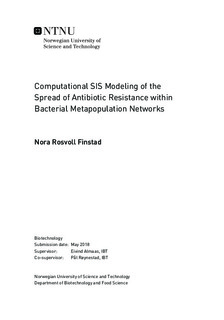| dc.description.abstract | The world faces a continually ongoing emergence of antibiotic resistance, and an almost non-existent development of new antibiotics to fight resistant bacteria. This leads to a substantial need for new and effective methods to stagnate the spread of antibiotic resistance. There exists a diversity of approaches for modeling spreading through a system. Each approach with their own strengths and weaknesses. For this thesis, a combination of a compartmental susceptible-infected-susceptible (SIS) modeling approach and a metapopulation modeling approach was chosen. The choice was based upon available data, and the general aim of the thesis. Various existing software were carefully evaluated and considered, but none of the studied software seemed to satisfy the initial needs and desire of the tool.
Initially, the aim was to develop a simple tool to study the effect of different parameters and network topologies in spreading situations. The desire was to show how a tool of this kind could be of use to predict the spread of infection; in this case antibiotic resistance, and how the tool could possibly help us establish measures to be taken in order to cease a spread or at least control the spreading activity. During the work of this thesis, a tool was developed, and several simulations were run in order to illustrate the utility of such a remedy as a help to stagnate the ongoing development of antibiotic resistance. Results from these simulation runs proved the importance of transit nodes for a spreading to progress, and that different network types display different spreading patterns. Results also demonstrated how parameters such as the frequency of cleaning, the growth rate of bacteria, and the fitness cost related to the acquisition of resistance genes, might affect systems. Among other things, results indicated an optimal cleaning interval of 6-9 hours, and a proportionality between increased growth rate and spreading activity. To illustrate how the tool may be utilized in real-life events, a semi-realistic simulation of a virtual hospital was conducted. Last but not least, limitations to the tool were established; limitations such as degree of realism.
This thesis presents a review concerning a selection of already existing research within the field of computational epidemiological modeling, as well a presentation of the developed network model tool and some of its functions. | |

